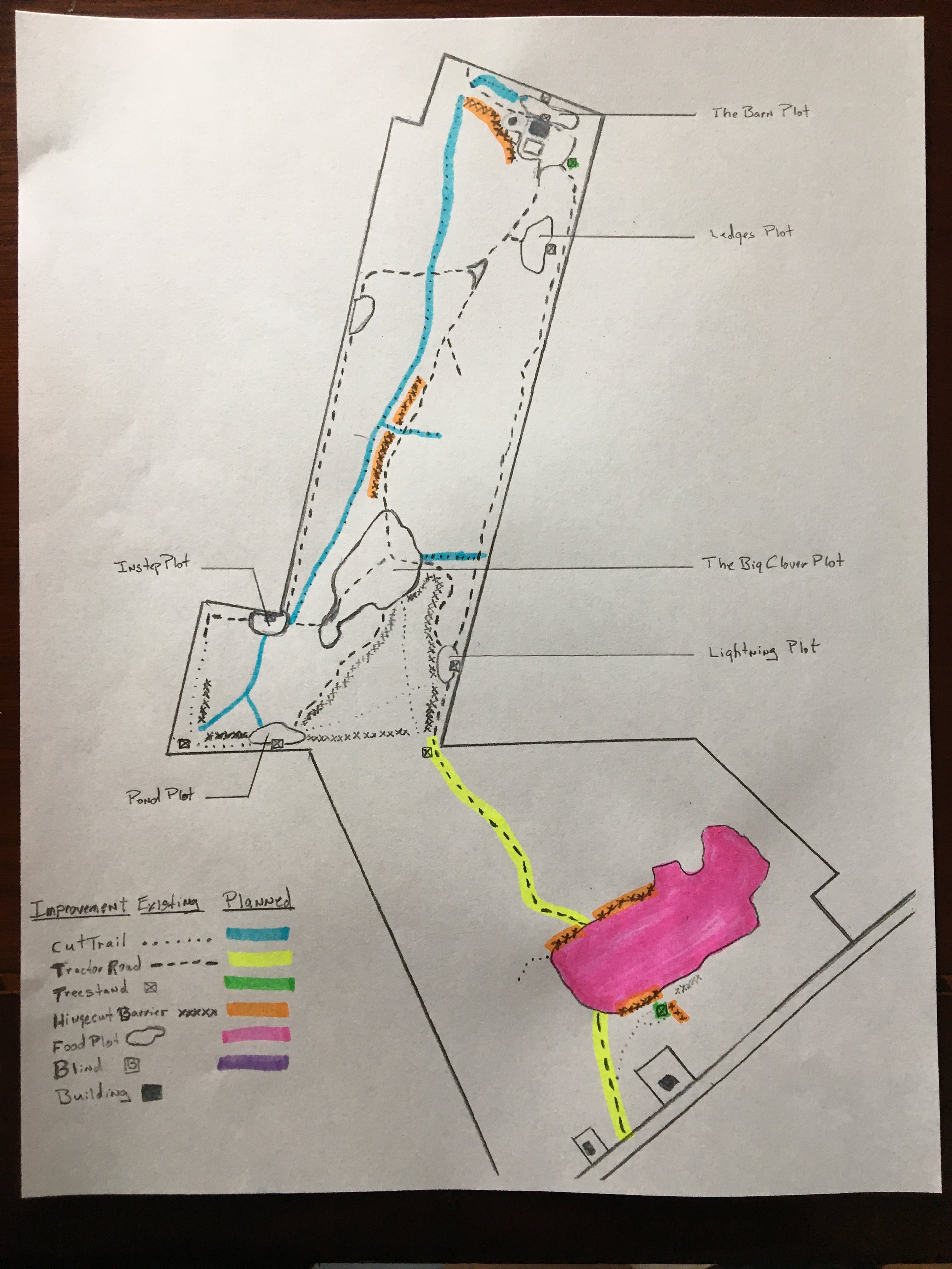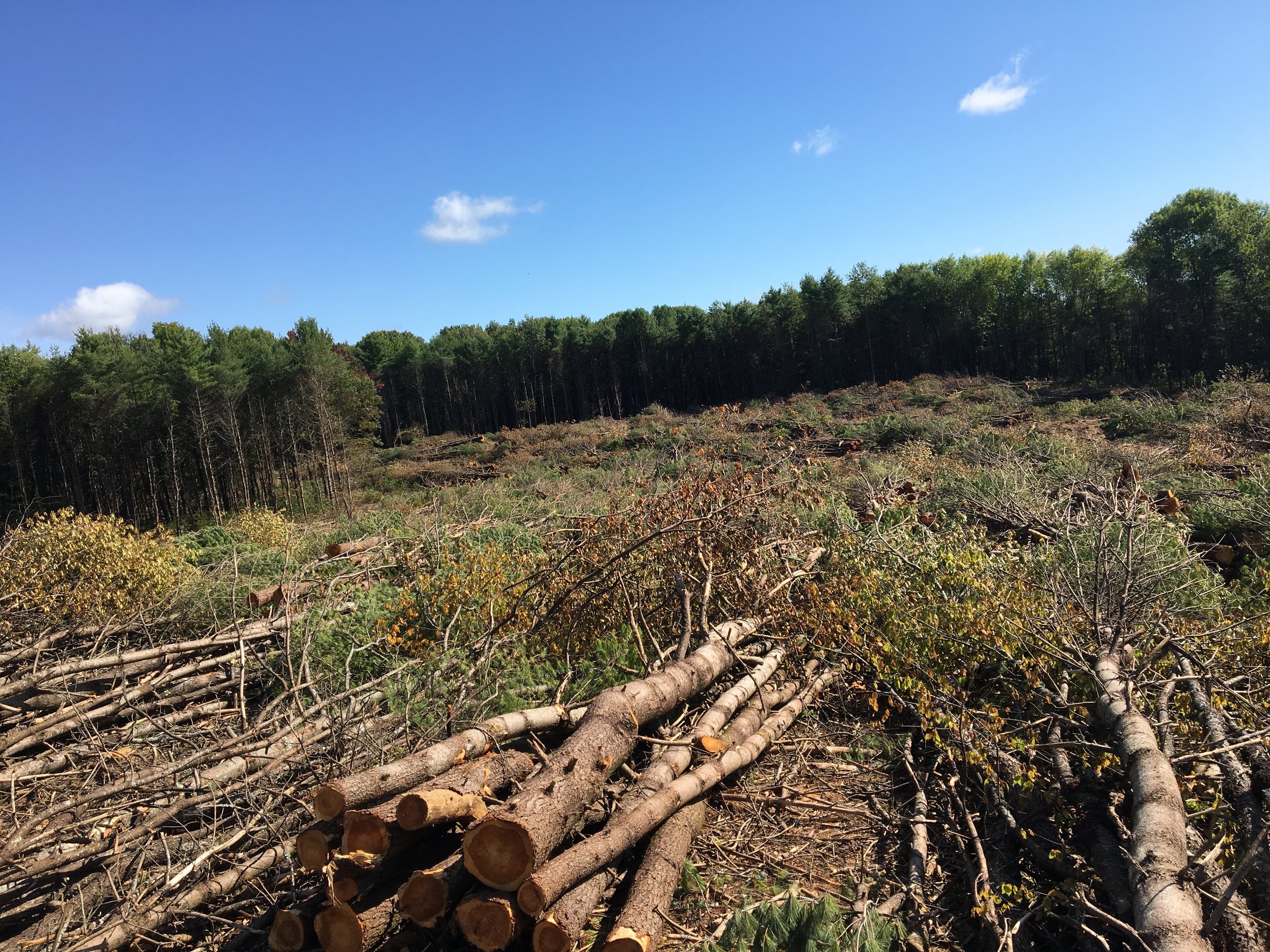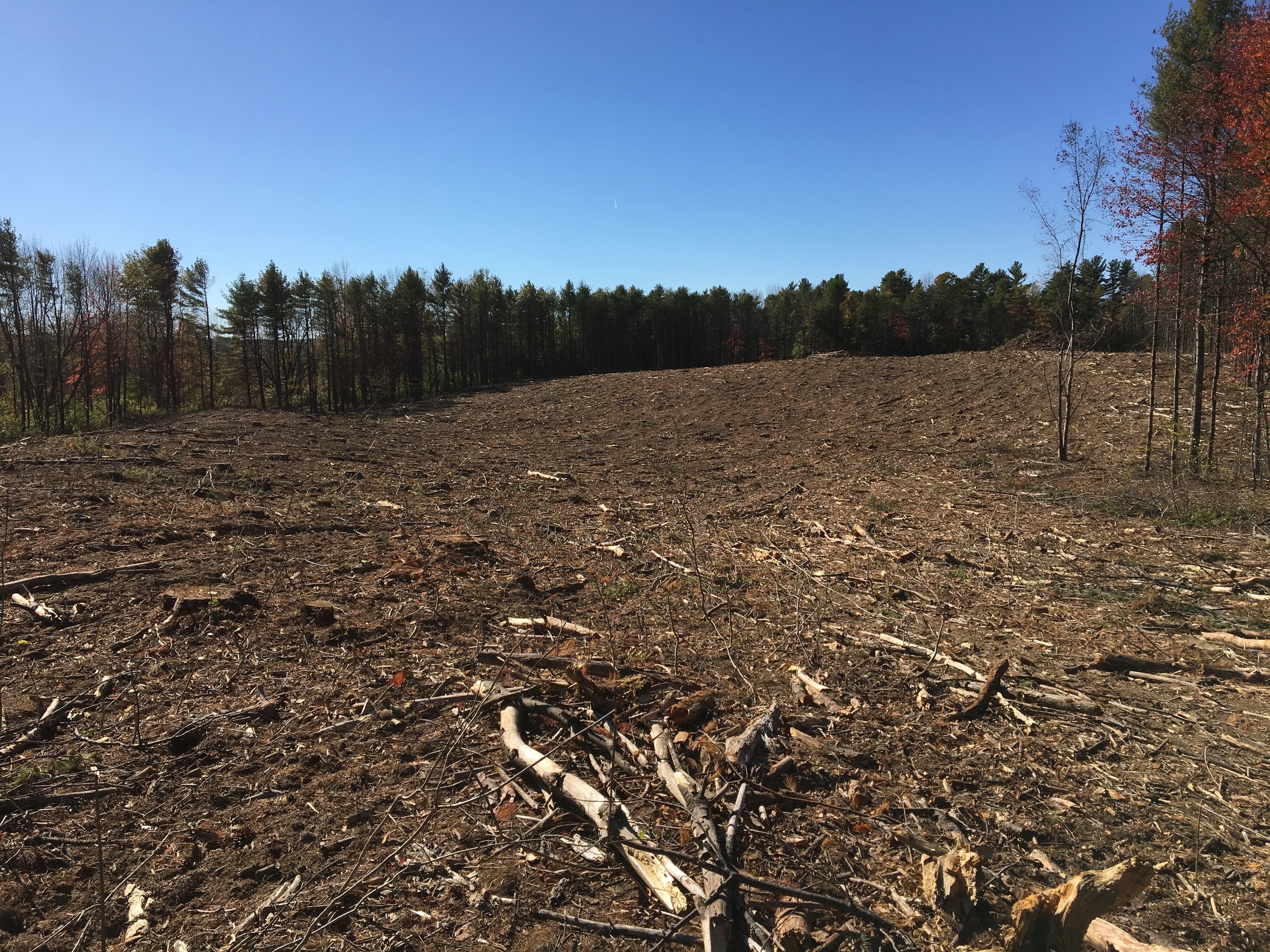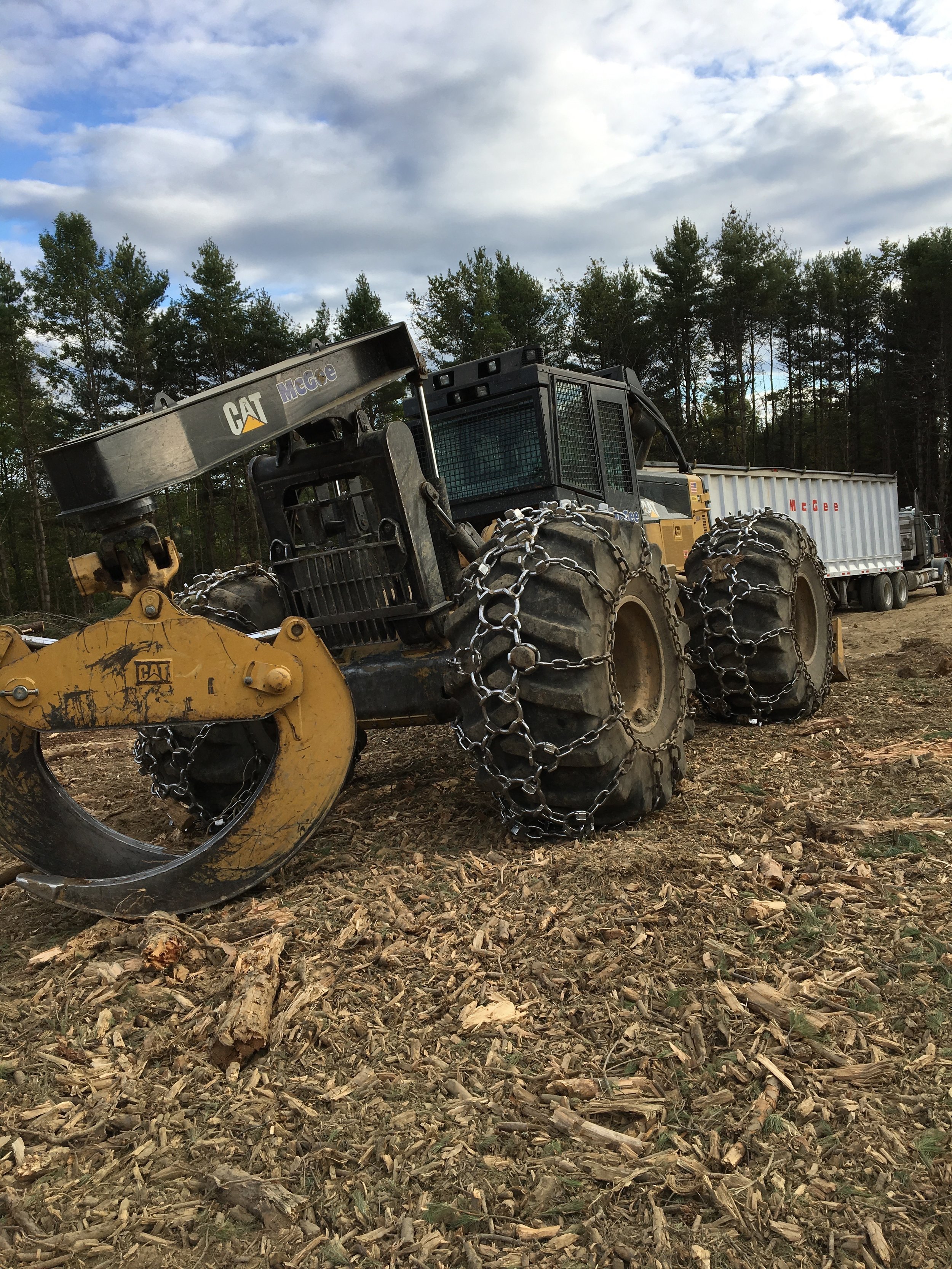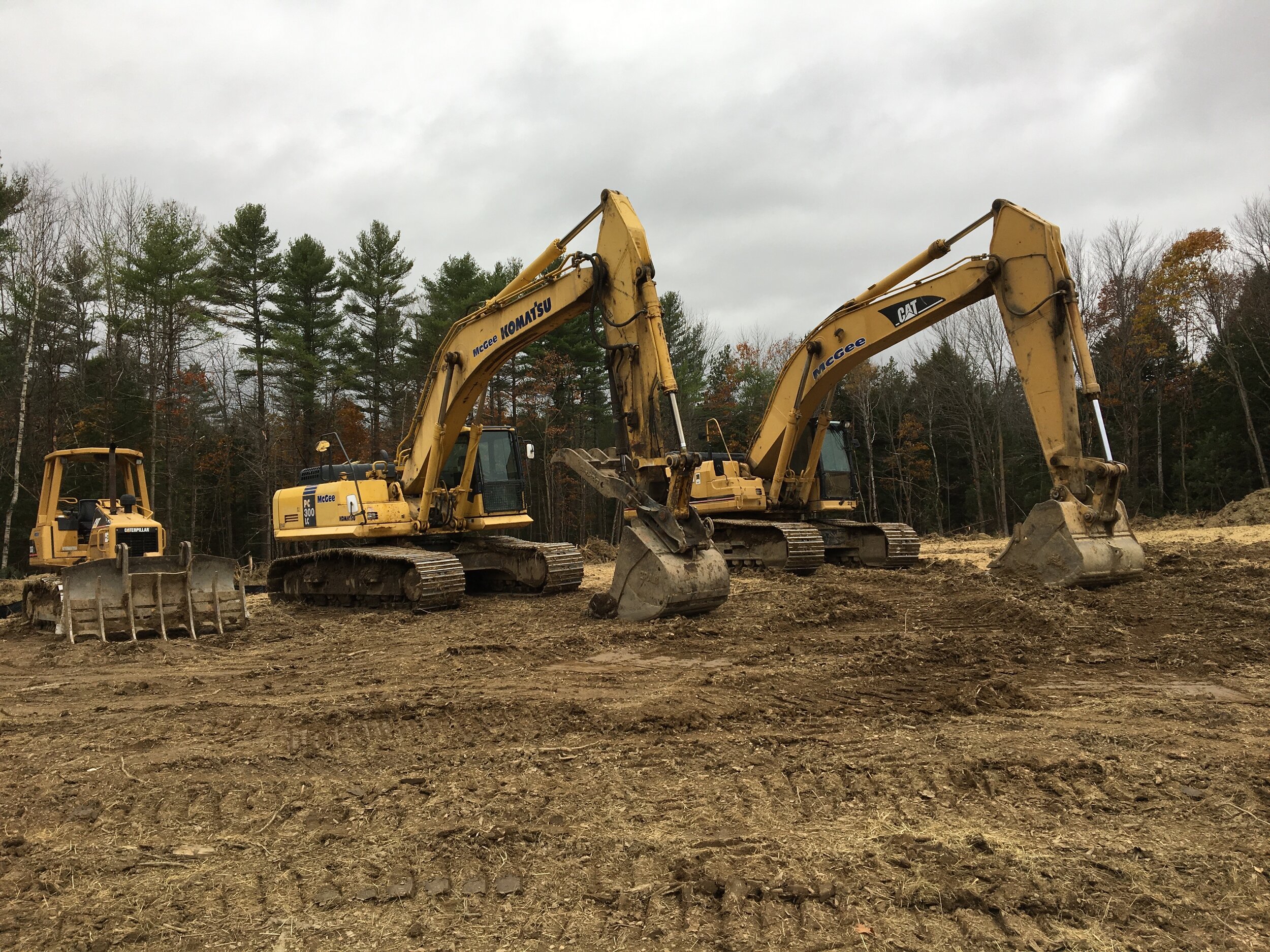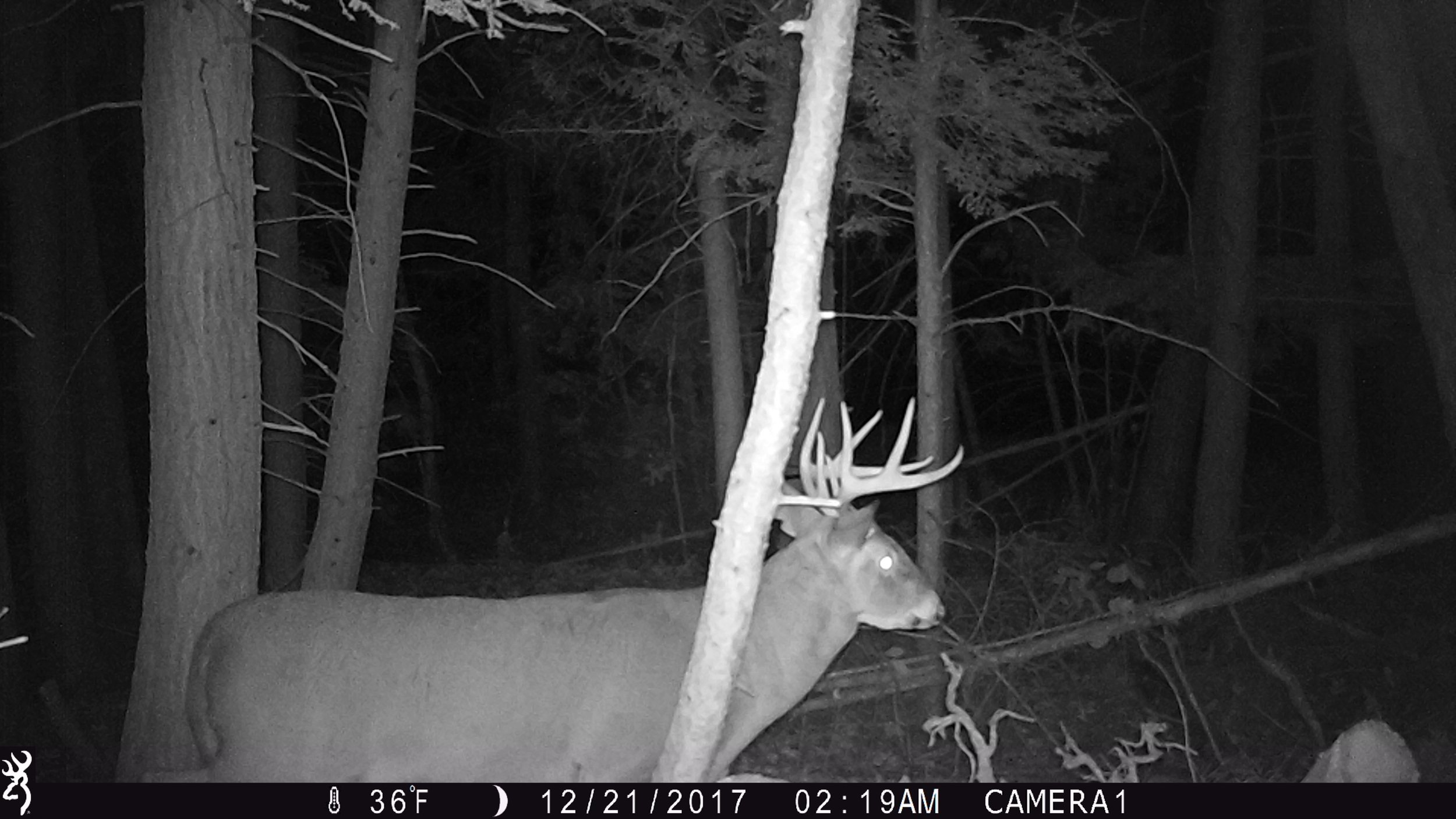Late 2017 Land Management
2017 revised plan including new acreage
I closed on the new 47 acre parcel in the summer of 2017. The first thing to do was to develop a plan for the first round of improvements on the new land, merging it into an overall design for the 108 acres. I had thought of several other improvements to the original 61 acres, so I would add those into the revised plan. There was an old logging road that ran through the new land, and I would improve that to give me tractor access to the big field.
The big field was, of course, the dense grove of twisted white pines, so I would need to clearcut that. The surrounding woods was old, mature trees, that would need to be selectively cut to bring light down to the forest floor so browse and bedding cover could grow. I knew that I wanted to clearcut the old field, and selectively cut the rest of the forrest, but I didn’t really know how to go about that. I would need help. I would need to hire a forester.
Starting to clearcut the old field, leaving trees on the edge for barriers
At the time, Jon Doty was a forester with Two Trees Forestry in Winthrop, and came recommended by a friend. I contracted with Jon to plan and manage the logging process, soup to nuts, and for that he would receive a percentage of the logging proceeds. He and I walked the land, discussing what my goals were and how best to achieve them. I then marked the clearcut and any specific trees, or groups of trees, that I wanted to be sure were not cut - one focus for me at this point was to be sure I left intact groups of trees that would be good locations for treestands.
The next step was for Jon to re-mark the clearcut with his own system, mark specific trees to be cut in the selective area, flag the boundaries, flag areas not to be cut, mark the road in from the street and the log loading area. He would then get bids from loggers, negotiate the contract, file necessary permits, oversee the work, and distribute the proceeds.
My first goal for the new land was to get the big food plot squared away as soon as possible. The first step toward this goal was cutting the trees, so Jon started with the clearcut - the selective cut would be done over the winter when the ground was frozen.
Trees waiting to be chipped
The clearcut started at the end of August. The vast majority of the 50 year old crooked white pines did not have value as saw logs, but they did as pulp. It’s amazing to watch modern logging equipment in action - quite different from the “old days” of just a few decades ago. Operated from air-conditioned cabs, they cut and bunched and hauled and chipped the softwood trees in very short order, taking them away to be made into paper. What wasn’t suitable for paper would be chipped for biomass energy.
The stumps looked to me to be easy to pull - that was wishful thinking!
Mad Max would have loved this
By the middle of October the clearcut was done and the big field-to-be was just stumps. The weather had been dry and I was thinking that if I could get the stumps pulled I could hire a truck to spread agricultural lime before the end of the fall. With the field limed in 2017, I would be able to plant in early 2018 - otherwise I would have to spread lime in the spring when it was dry enough to get the truck in, and then wait for the lime to work before seeding in mid-summer. At least that was what I was thinking when the loggers were done and the stumps were ready to go.
I thought I could do the job myself with an excavator, so I rented a medium-size 30,000 lb. machine and had it delivered to the site. I have a lot of time in on my backhoe, so operating an excavator wasn’t much of a challenge. I started on in on the corner nearest the log loading yard - the yard had been de-stumped by the logger when preparing it to function as the truck turnaround and chipping work area. I moved the tracked excavator over and began to lever the stumps out, digging the bucket under the edge of the first stump’s roots and prying at it. I could work the bucket around the edges and, after a lot of work, get the stump to come loose from the dirt. The rental machine had seen a lot of action, so every joint was loose.
When you pry at the edge of a stump and haven’t yet loosened it, the front of the 30,000 lb. machine’s tracks lifts off the ground and, if you’re not extremely careful and move very slowly to get a better bite, the machine slams back down with a jarring force that shakes you to your bones. That, and trying to operate on sloped ground, made me quickly realize that this was going to require time and patience. A bigger excavator that weighed a lot more would be able to get the stumps out with one or two swipes - I was taking 10. After just a few stumps, and no more than two hours behind the joystick, I decided that the job was too big, and my rental too small.
The job required huge excavators and a dozer with a rake blade
Dozer working with rake blade
Throwing in the towel, I called a contractor to do the job. The cost was significant, and getting on their schedule would push my timeline back, but there wasn’t really another choice. When I pulled out a stump with my rental excavator I left a large hole in the ground that became what my WWII army veteran father would call a tank trap. It would be an obstacle for a 30,000 lb. excavator, but not for a bigger machine operated by a pro. The contractor came in with two machines that were each more than twice the size of my rental. Plus they had a bulldozer with a rake blade that would push the stumps and rocks to the side of the field, but leave as much of the topsoil as possible. I had them push the rocks and stumps to the field/woods edge, creating a berm that would restrict deer entering and exiting the field to just six openings where they wouldn’t have to climb over the berm - the better to send them past my stands.
First doe harvested
Now early November, the team cleared the field in just a few days, giving me hope that I could get the lime truck in before winter. To comply with Maine DEP rules, the contractor covered the raw dirt field with hay mulch to protect it from erosion over the winter and into the spring. Unfortunately, as he finished-up the rain started and the field became too soft to spread lime. The lime would have to wait - I put things to bed for the winter.
The quality of my hunting on the land during the fall of 2017 was dramatically improved. I put up stands and hunted several times on the new land, but most of my time and action was on the original 61 acres. The food plots were producing tons of forage and I had several doe families bedding nearby.
Three deer in a lush food plot
A couple weeks into the Expanded Archery season I was hunting over the Instep plot in the southwest of the original parcel. In the late afternoon a doe family worked their way out from the thick cover to feed on the lush clover. With a light breeze blowing from them to me, I knew I had plenty of time to wait for a perfect shot. After 30 minutes watching them I made an easy shot on the largest doe, watching her dash back into the cover as the others scattered. Ok, we won’t talk about the fully-amortized price per pound of this venison, but we can linger on the feeling of satisfaction given by harvesting a mature deer with archery equipment on my own land. Three years of hard work has now put meat in the freezer and created countless more bowhunting opportunities for the years to come.
I hunted many more times during the fall of 2017, sitting over food plots and game trails on the original 61 acres with the sound of logging equipment working on my new land in the distance. I had a few cameras out that year, fewer than 2016 because I felt like I knew where the deer were and didn’t want to spook them by coming in to pull the memory cards. Cuddeback, a manufacturer of game cameras, was just coming out with their Cuddelink system that wirelessly links multiple cameras together so you only have to pull photos from one unit - I had that on my list of things to look at for 2018.
I had mature bucks on my land, I just didn’t see them come by my stand
As far as I could tell, by looking at game camera photos, working on my farm, and hunting from treestands, I had more than 18 deer regularly spending time there. After harvesting the one doe in the Instep plot I passed on many more deer, hoping to get a chance at a buck. One day it was two does in front of me, another time four, three, or six. I had three does in front of me one afternoon at the Lightning plot, comfortably feeding until they jerked up their heads looking at something behind me that I couldn’t see. They suddenly ran off like a shot, and I heard shuffling feet in the leaves behind me - it sounded like a trespasser was approaching and I was getting mad.
But it turned out to be a group of six does that walked into the food plot and began to feed - deer are usually very quiet when they move but 24 feet walking through dry leaves makes quite a racket. Nine deer in front of me for more than an hour. Ok, not a big deal for Iowa or Ohio, but we’re talking about Maine. Just seeing a deer when you’re hunting in Maine is cause for celebration. I never did see a buck while I was hunting my land in 2017, but I had meat in the freezer and I sure did have fun!
To learn about my 2018 land management experiences, Click Here To Go Forward to 2018.
To revisit the last page: Click here To Go Back To Early 2017.
BEFORE: The old field had been planted 50+ years ago with white pine
AFTER: after clearcutting, de-stumping, and lots and lots of raking
